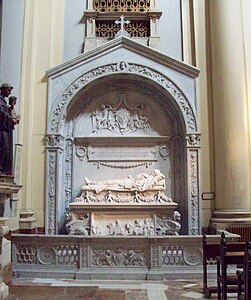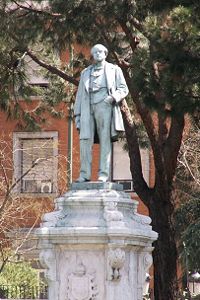Jerome Suñol
Jerónimo Miguel Suñol y Pujol (Barcelona, December 13, 1839-Madrid, October 16, 1902) was a Spanish sculptor.
Biography
He was born in Barcelona in 1839. From humble origins, he trained at the Lonja School in Barcelona, complementing his studies in the workshop of an image maker named Passavell and, above all, in the workshop of the brothers Venancio and Agapito Vallmitjana. In 1858 he obtained a scholarship to study in Rome, where he met his future wife, Adela Rossi Orsini, with whom he had two daughters. During his Italian stay, he coincided with the war for Italian Unification and was on the verge of being shot for being confused with a Garibaldino. There he established contact with Mariano Fortuny and his circle of friends. It is at this time that he made the sculpture "Dante", one of his best-known works, with which he won a silver medal at the National Exhibition of Fine Arts in 1864. One of the versions of Dante is in the National Art Museum of Catalonia where other of his works are kept (female bust, learning as a sculptor) and also the portrait of him painted by Fortuny. The original plaster and another version of Dante in bronze can also be found in the Museo del Prado.
Another notable work by Suñol is Himeneo, with which he won a medal at the National Exhibition of Fine Arts in 1866.
When he returned from Rome, he settled in Barcelona (1875) and, later, in Madrid, where he ended up residing and where he gained some recognition, developing an important artistic career. He dedicated himself to public statuary and religious sculpture, and also received numerous private commissions for the decoration of palaces.
Since 1882 he was part of the Royal Academy of Fine Arts of San Fernando. His disciples or collaborators were the sculptors Aniceto Marinas, Antonio Parera, Pagés Serratosa, Medardo Sanmartí and Cipriano Folgueras, among others.
Jerónimo Suñol is an outstanding exponent of the significant expansion and productive potential achieved by Catalan sculptors during the XIX century, with the capacity to export work to all of Spain and also abroad. His style can be ascribed to realism prevailing during the second half of the XIX century. His sister Dolores married Domingo Batlló y Barrera, of the Batlló lineage, owners of the important Can Batlló textile factory, his nephew Romano Batlló y Sunyol or Suñol, who was a photographer, took many photographs of him and inherited his workshop. Finally, an important part of this collection was incorporated into the Barcelona Art Museums.
His last work was the sculpture of the Marquis of Salamanca. He died in Madrid in October 1902 without finishing a female figure based on the protagonist of the novel Nana by Émile Zola.
Works
- Thinking Dantein the Museo del Prado, Madrid (1864)
- Himeneo (1866)
- Petrarca (1866)
- Mausoleum of Leopoldo O'Donnell, in the church of Santa Barbara of Madrid (1870)
- Marble statue of the Monument to Columbus in Madrid (1885)
- Bronze replica of the previous statue in Central Park of New York (1892)
- Urna funeral of General Mariano Alvarez de Castro, in the Church of San Felix de Gerona (1880)
- Monument to the Marquis of Salamanca in Madrid (1902)
- San Pedro and San Pablo, in the Basilica of San Francisco the Great of Madrid
- San Francisco Javier, in the Sanctuary of Javier, in Navarre
- Decoration of the watch of the Banco de España in Madrid
- Staircase and various sculptures by Linares Palace in Madrid
- Monument to Pedro Duro in La Felguera, Asturias (1895)
Awards and recognitions
- National Exhibition of Fine Arts in 1866. 1st class Medal to the merit granted by Isabel II in 1867 for her work (Himeneo).
- Knight Grand Cross Royal Order of Isabel the Catholic, 1889.
- 1.o Centenary of the United States. U.S. Special mention in Philadelphia International Exhibition, 1876.
- Royal Academy of Fine Arts of San Fernando, 1878.
- Award at the National Exhibition of Fine Arts for Dantegranted by Isabel II in 1865.
- Paris Universal Exhibition in 1867, III Sculpture Award (by Himeneo).
- He also carried out recognized models and projects and his experience was required to prosecute the works of other artists.
Contenido relacionado
Einar Arnaldur Melax
John Herrera
Canberra



